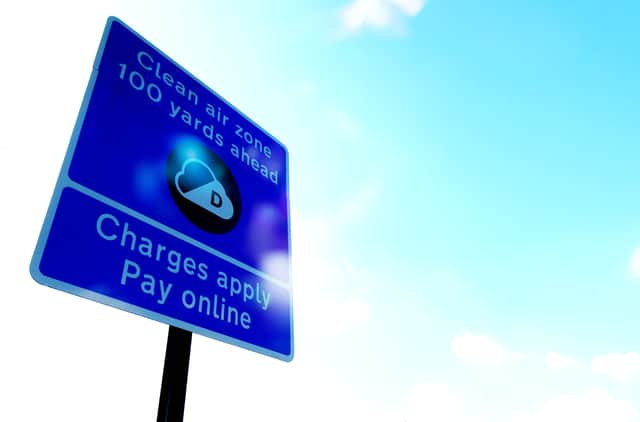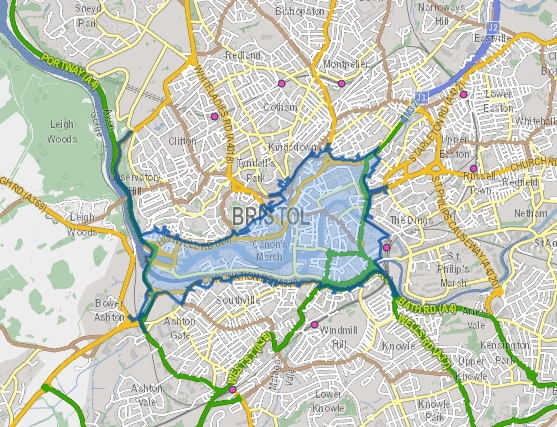How much you will need to pay in Bristol’s Clean Air Zone and what support is available


The introduction of Bristol’s Clean Air Zone appears to have been staggered, to say the least.
Plans for the initiative, which aims to combat levels of nitrogen dioxide across the city, were drafted up well before the pandemic, with an ensuing back-and-forth between Bristol and Westminster over how and when the Clear Air Zone should come into force.
Advertisement
Hide AdAdvertisement
Hide AdWith environmental groups warning that further delays will cost lives, the Government had ordered Bristol City Council to have its Clean Air Zone in place by October this year.
But this has now been put back again until summer 2022.
According to the city council, the delay means the city still remains on track to reduce pollution to within legal limits by 2023.
Bristol Mayor Marvin Rees also said it had allowed the council to ‘work through the data in detail’ in order to secure ‘the best deal for residents and businesses’.
Here’s everything you need to know.
What is a Clean Air Zone?
July marked four years since Client Earth took the UK Government to court for the third time for breaching EU nitrogen dioxide (NO2) standards in most of its major cities.
Advertisement
Hide AdAdvertisement
Hide AdThe Government responded by issuing clean air directives to these cities, instructing them to reach compliance with the legal standard of nitrogen dioxide ‘in the shortest possible time’.
Bristol was directed to introduce a ‘Category D’ Clean Air Zone as part of these plans.
A Clean Air Zone is a specific location that aims to reduce public exposure to nitrogen dioxide through restrictions on the highest polluting vehicles, encouraging the use of cleaner vehicles and people to walk, cycle or use public transport.
There are four types of Clean Air Zone, differentiated by the type of vehicles penalised in each one.
Advertisement
Hide AdAdvertisement
Hide AdCategory A has the fewest vehicles paying charges, while Category D has the most.
Why is a Clear Air Zone needed?
The Clean Air Zone aims to get levels of nitrogen dioxide on the city’s roads down to legal limits as quickly as possible.
Air pollution is linked to a number of very serious health conditions and can cause premature death.
According to Clean Air for Bristol, exposure to nitrogen dioxide and fine particulate matter contributes to 300 deaths in the city each year.
Advertisement
Hide AdAdvertisement
Hide AdThis represents about 8.5 per cent of deaths in Bristol where air pollution is a contributing factor.
Therefore, action must be taken to protect future generations and clean up the city-region atmosphere.
Which roads are included?
The Clean Air Zone will apply 24 hours a day, seven days a week.
The zone stretches from the Cumberland Basin to Temple Meads, as seen on the map below.


Which vehicles are included?
Advertisement
Hide AdAdvertisement
Hide AdMore than 71 per cent of vehicles in Bristol are already compliant, so only a minority of vehicles driving in the Clean Air Zone will be charged.
The current scheme would see every diesel vehicle and petrol vehicle dating from before 2006 charged for entering the zone.
This includes private cars, taxis, light goods vehicles (LGVs), heavy goods vehicles (HGVs), buses and coaches.
Previous plans to ban diesel cars in the city altogether have been scrapped.
Will I be able to make my vehicle comply?
Advertisement
Hide AdAdvertisement
Hide AdThe plans have come under fire in the past, with some residents living in the Clean Air Zone arguing they are effectively being ordered to purchase new vehicles.
Tradespeople have also raised concerns about being put at huge disadvantage for hefty charges in order to access other parts of the city for work.
But the council say helping people and companies to upgrade their vehicles to greener alternatives is a key priority, though the practicality of this has been contested by business and trade groups.
A loans and grants scheme to help residents and businesses upgrade their vehicles will be launched this autumn.
Advertisement
Hide AdAdvertisement
Hide AdMore people will also eligible for financial support after Bristol City Council announced it would raise its low-income threshold from £24,000 to £27,000 by early 2022.
How much will it cost for non-compliant vehicles?
Private petrol and diesel cars that are not compliant face charges of £9 a day - the same goes for taxis and LGVs.
HGVs, buses and coaches that are not compliant will face daily charges of £100.
Non-compliant vehicles would only be charged once in each 24 hour period. If you live within the Clean Air Zone and drive a non-compliant vehicle, you’d only be charged if you made a journey.
Advertisement
Hide AdAdvertisement
Hide AdMr Rees said: “We don’t want to charge people, we want to provide the opportunity to work with us – hopefully, switching to a cleaner vehicle and walking or cycling for shorter journeys as well as using public transport.
“The Clean Air Zone will clean up the vehicles on our roads and reduce traffic travelling into the city. Alongside ongoing initiatives, it will improve air quality in the city by encouraging more people to choose cleaner ways of travelling.
Exactly what help is there for motorists and businesses?
- The Council state that £2.1m is being made available for Bristol bus and coach companies to help them buy cleaner vehicles or upgrade existing vehicles to meet the Clean Air Zone’s emission standards
- More than £32m is being made available to help businesses upgrade to cleaner vehicles. Commercial vehicle owners in the zone with existing finance agreements will also be able to apply for a one-year exemption
- All residents inside the zone with a non-compliant vehicle will be offered a one-year exemption to give them time to apply for financial support to switch to a cleaner vehicle or different way of travelling.
- The plans also include £720,000 for a new cycle scheme through Old Market that will provide the missing link on one of the city’s key cycle routes between the new segregated Baldwin Street cycle lane and the Bristol to Bath Railway Path
- Free electric bike loans, cycle training, free bus tickets, discounted car club membership and support to buy electric cars will also be available to encourage more people to travel differently and use cleaner more sustainable transport
- Bristol Royal Infirmary patients and visitors will be exempt from the Clean Air Zone charge
- Blue Badge holders will be able to apply for a one-year exemption if their vehicle doesn’t meet the zone’s emission standards
- People with a disabled tax class vehicle or disabled passenger tax class vehicle are automatically exempt from the charge
What effect does air pollution have on health?
Air pollution has been linked to flare-ups for health conditions and a trigger for heart attacks and strokes.
Pregnant women could also be affected as it has been suggested poor-quality air is linked to premature births, low birthweights for babies and miscarriages.
Advertisement
Hide AdAdvertisement
Hide AdChildren are also particularly susceptible to air pollution as their organs are still developing.
Breathing polluted air has been linked to childhood asthma as well as aggravating attacks, lung damage and a potential lifetime of more serious health issues.
It has also been suggested that if action is not taken then by 2035 air pollution could come with a £5.3bn cost to health and social care.
Comment Guidelines
National World encourages reader discussion on our stories. User feedback, insights and back-and-forth exchanges add a rich layer of context to reporting. Please review our Community Guidelines before commenting.